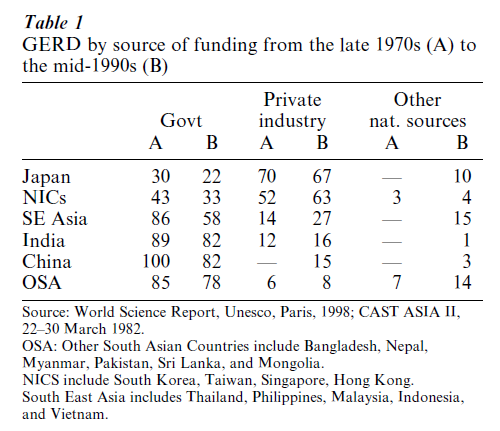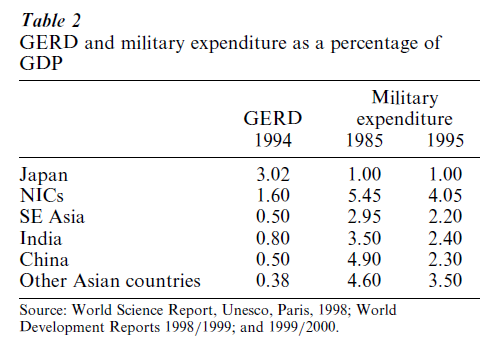View sample Science Funding in Asia Research Paper. Browse other science research paper examples and check the list of research paper topics for more inspiration. If you need a religion research paper written according to all the academic standards, you can always turn to our experienced writers for help. This is how your paper can get an A! Feel free to contact our research paper writing service for professional assistance. We offer high-quality assignments for reasonable rates.
Science funding refers to national expenditure, from both public and private sources, for the institutionalization and promotion of a variety of scientific activities conventionally termed research and development (R&D). These may take the form of basic, applied, and development research undertaken or sponsored across a range of science and technology (S&T) institutions in national S&T innovation systems. In the postwar era, the concept of science funding assumed considerable importance in the national policies of Asian countries. The government, both as a patron and as a powerful mediator, played a significant part in shaping the structure and direction of science funding.
Academic Writing, Editing, Proofreading, And Problem Solving Services
Get 10% OFF with 24START discount code
In the latter half of the twentieth century, the belief in science as a symbol of ‘progress’ was transformed into an established policy doctrine in the Asian region. Creating wealth from knowledge and achieving social, political, and military objectives came to be closely associated with deliberately fostering S&T activities through funding scientific research. In the mid 1990s, the Asian region accounted for 26.9 percent of the world’s gross expenditure on research and development (GERD), which was US$470 billions in 1994. While Japan and newly industrializing countries (NICs) accounted for 18.6 percent, South East Asia, China, India, and other South Asian countries accounted for 0.9 percent, 4.9 percent, 2.2 percent, and 0.3 percent respectively. Within the Asian region, whereas Japan and NICs accounted for about 69 percent, other countries accounted for 31 percent of total science funding.
Three main interrelated approaches underlie the concept of science funding in Asian countries. The first approach underlines the importance and essential nature of public or government funding of R&D as a ‘public good’ that improves the general interest and welfare of the society or nation as a whole. The public good approach emphasizes the funding and generation of knowledge that is non-competitive, open for public access, and non-exclusive. As private firms and the market are unable to capture all of the benefits of scientific research, they often tend to under-invest in R&D, which is also a key component of the process of innovation. It is in this context that public funding becomes important by bearing the social costs of generating scientific knowledge or information. Further, numerous studies have shown that public funding of scientific research as a public good yields several social and economic benefits (see Arrow 1962, Pavitt 1991). In contrast to institutionalized and ‘codified’ forms of knowledge, scientific capacity in the form of ‘tacit knowledge’ is seen to be embodied in research personnel trained over a period of time. Thus, publicly supported training in higher educational settings and networks of professional associations and academies forms an important component of science funding.
A closely related second approach to science funding is state sponsorship of military and defense related strategic R&D. Even though there is considerable spinoff from military R&D to the non-military sectors of economy, the main rationale for the importance given to such research is national security. Most countries in the world, including those in the Asian region, spend more money on military and defense- related scientific research activities than in the civilian R&D domain.
The third approach essentially recognizes the importance of private sources of funding for scientific research. Although private patrons have always played an important part in supporting S&T-related research activities, the postwar decades, particularly the 1980s and 1990s, witnessed a remarkable shift from public to private sources of funding of science. The significance of private science funding has grown since the 1980s, as the ‘linear model,’ which was based on the perceived primacy of basic research, began to lose its credibility. Insights from studies on the economics of innovation came to substantiate the view that it is ‘downstream’ development spending in the spectrum of R&D ‘that plays a crucial role in determining who gets to capture the potential rents generated by scientific research’ (Rosenberg 1991, p. 345). Private industrial firms, rather than government funding, dominate this segment of R&D in Asia as in other regions. Second the importance of private industry as a source of science funding attracted considerable attention from the mid 1980s, as the success of Japan and other East Asian NICs came to be analyzed from the perspective of how these countries transferred the burden of science funding from public to private sources.

As the expenditure on military R&D is largely met by governments, the pattern of GERD in the Asian region can be explored in terms of public and private sources. As Table 1 shows, three broad subregions are discernible in the Asian region insofar as the source of science funding is concerned. While private industry accounts for approximately two-thirds, government accounts for one-third of the total R&D expenditure in the case of Japan and NICs. There has been a significant transformation in the increase of private funding of science in South Korea. Private sources accounted for about 2.3 percent of GDP, that is, 80 percent of total R&D funds, which is one of the highest levels in the world. In Japan, Singapore, and Taiwan, over 65 percent of total R&D spending is financed by private industry. Much of this transformation is the result of state mediation and institutional mechanisms which offer appropriate incentives for the private sector to invest in R&D.
In the second subregion of South East Asia, there has been a perceptible change in private industry’s share of total R&D, which increased from 14 percent to 27 percent, whereas the government’s share witnessed a decline from 86 percent to 58 percent between the late 1970s and the mid-1990s. In Southern Asia, which comprises China, India, and other South Asian countries, the government continues to be the main patron for science funding. The private sector accounts for less than 16.5 percent. In China and India, while the proportion of private funding of R&D increased to 15 percent and 4.4 percent respectively during the late 1970s and the mid-1990s, the private sector is likely to play a more dominant role in the 2000s. This is because these countries are witnessing considerable foreign direct investment and economic restructuring which are fostering liberalization and privatization. Except in the case of the Philippines and Sri Lanka, where about a quarter of total R&D funding is met by foreign sources, foreign funding hardly plays a significant role in the Asian region as whole.
Although there is no established correlation between GERD as a percentage of GDP and economic growth rates, this indicator has assumed great significance in S&T policy discourse in the 1990s. Whereas the industrially advanced countries spend between 2 percent to 3 percent of GDP on R&D activities, middle-income countries such as the NICs and some others in the South East Asian region spend over 1.5 percent. The poorer developing countries spend less than 1 percent and the countries falling at the bottom of economic and human development rank index spend even less than 0.5 percent. This general trend is also largely borne out in Asia, as shown in Table 2. However, the relation between different types or forms of R&D and economic growth has also come into sharper focus.

Even though the of share private industry in overall R&D effort is emerging as one of the determinants of economic dynamism, some studies draw attention to various national technological activities (in relation to the national science base) which have a direct bearing on national economic performance measured in terms of productivity and export growth (see Pavitt 1998, p. 800). For instance, as shown in Table 3, the most economically dynamic NICs such as Taiwan and South Korea began with relatively weak scientific strength, as did India in the early 1980s. Nevertheless, they outperformed India by the early 1990s in terms of the change in their share of world publications, as well as in the share of registered patents in USA. Taiwan and South Korea not only spent a much higher proportion on R&D as a percentage of GDP, but the privately dominated R&D structure was such that it gave high priority to patenting. In actual terms, while Japan and South Korea filed 335,061 and 68,446 patents in their respective countries, India filed only 1545 patents in 1995–6. Further, whereas high technology exports as a proportion of total manufacturing exports in Japan, South Korea, Hong Kong, and Singapore registered 39 percent, 39 percent, 27 per- cent, and 71 percent respectively, India registered hardly 10 percent in 1996, which is much lower than the figure for China (21 percent) for the same year.

As indicated in Table 2, there is a good deal of military burden in most of the Asian countries. Even though there was drastic reduction in military expenditure as a percentage of GDP between 1985 and 1995 in the region, all the Asian countries and subregions still spend three to four times more on military activities than on civilian R&D. While Pakistan maintained over 6 percent, Sri Lanka increased its military expenditure as a percentage of GDP from 2.9 percent to 4.6 percent between 1985 and 1995. Japan is the only country in the Asian region that limited its military expenditure to 1 percent of GDP while spending over three times this figure on civilian R&D (3.1 percent) during the same period.
In terms of the sectoral focus of R&D funding in the Asian region, a contrasting picture emerged. Japan and NICs directed their science funding to high technologies, capital, exports of engineering goods, advanced materials, modern biology, and basic research in information and communication technologies. In the 1990s, Japan, South Korea, and Singapore registered greater proportions of private sector funding than even Germany and the USA. Japan’s R&D expenditures have increased eightfold over the 20 year period from 1971 to 1993, which is the highest rate of increase among the industrially developed nations.
At the other extreme are the Southern Asian countries, including China, India, Pakistan, Bangladesh, Nepal, Myanmar, and Sri Lanka, where R&D funding related to agriculture and to the manufacturing sector assumed equal importance, as over 60 percent of their populations was dependent on agriculture. Another revealing feature about countries such as China, India, and Pakistan was the importance given to military and strategic R&D, which consumed 45 to 55 percent of the total R&D budget.
In most of the South East Asian countries, the contribution of agriculture to the GDP witnessed a considerable decline in contrast to Southern Asian countries. In terms of sectoral contribution to the GDP, none of the South East Asian countries ac- counted for more than 26 percent (the figure for Vietnam) for agriculture in 1998. The manufacturing and service sectors witnessed unprecedented growth rates between 1980 and 1998. Though these countries spend no more than 0.5 percent of GDP on R&D, the thrust of science funding is directed to manufacturing, industrial, and service-related activities. Agricultural research consumes only 5–10 percent of the total R&D funding, much less than in the Southern Asian countries.
Bibliography:
- Arrow K 1962 Economic welfare and the allocation of resources for invention. In: Nelson R (ed.) The Rate and Direction of Inventive Activities. Princeton University Press, Princeton, NJ, pp. 609–25
- Pavitt K 1991 What makes basic research economically useful. Research Policy 20, pp. 109–19
- Pavitt K 1998 The social shaping of the national science base. Research Policy 27, pp. 793–805
- Rosenberg N 1991 Critical issues in science policy research. Science and Public Policy 18, pp. 335–46
- UNESCO 1998 World Science Report. Paris
- World Development Report 1998/1999
- World Development Report 1999/2000




